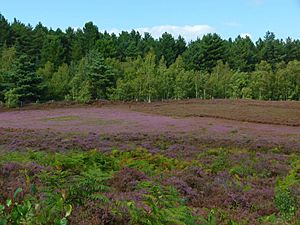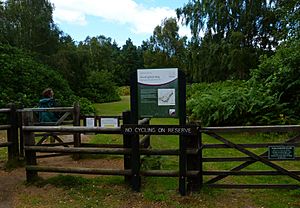Dersingham Bog facts for kids
| Site of Special Scientific Interest | |
 |
|
| Area of Search | Norfolk |
|---|---|
| Interest | Biological Geological |
| Area | 159.1 hectares (393 acres) |
| Notification | 1986 |
| Location map | Magic Map |
|
Designations
|
|
| Official name: Dersingham Bog | |
| Designated: | 12 September 1995 |
|---|---|
| Reference #: | 751 |
Dersingham Bog is a special natural area in Norfolk, England. It covers about 159 hectares (393 acres) and is important for its unique plants, animals, and geology. It's officially recognized as a Site of Special Scientific Interest and a National Nature Reserve. It's also a Ramsar site, which means it's a wetland of international importance. This area is part of the beautiful Norfolk Coast Area of Outstanding Natural Beauty.
Contents
Exploring Dersingham Bog
Dersingham Bog is located near the villages of Dersingham and Wolferton in West Norfolk. It's one of the last wild places in this part of Norfolk. Most of the surrounding land is used for farming. This special reserve is actually part of the Sandringham Royal Estate.
The Ground Beneath Your Feet: Geology
Dersingham Bog sits on a special type of rock formation called the Greensand escarpment. An escarpment is like a steep slope or cliff. Scientists have found a unique rock here from the Lower Cretaceous Period. This period was a very long time ago, when dinosaurs roamed the Earth! This rock, called 'Dersingham Formation', helps us understand the history of the land in this region.
Amazing Habitats and Wildlife
Dersingham Bog is home to three different types of natural areas. These are wet mire (like a bog), dry heathland, and woodland. Each habitat supports different kinds of plants and animals.
Wet Mire Habitat
The low-lying parts of the reserve have a wet acid peat mire. The ground here stays waterlogged for most of the year. Dersingham Bog has the largest remaining example of this rare habitat in East Anglia.
The wet peat soil is perfect for many unique plants. You can find bog asphodels, which have bright yellow flowers. There are also round-leaved sundews, which are small carnivorous plants that catch insects. Other special plants include white beaked sedge and cranberry plants.
This wet area is also home to rare insects. Look out for the black darter dragonfly, a small, dark dragonfly. You might also spot moths like the light knot grass. If you visit at night, you might even see glowworms!
Dry Heath and Woodland
The mire is next to a steep slope called an escarpment. This slope has large areas of dry heathland and woodland. This escarpment shows where an ancient coastline used to be.
The woodland at Dersingham is fairly new. It has trees like Scots pine, oak, sweet chestnut, sycamore, and birch. These trees provide homes for many birds. You might see colorful redpolls or crossbills with their unique beaks. Other birds include long-eared owls, tree pipits, woodlarks, shelducks, nightjars, and sparrowhawks.
Visiting Dersingham Bog
Dersingham Bog is open for everyone to explore. There are many clear paths that make it easy to walk around and discover this wild place. You can park your car for free at Wolferton and Scissors Cross.
Who Looks After the Bog?
The natural reserve is managed by an organization called Natural England. They work to protect and improve the natural environment in England.
A Bench for John Denver
There is a special bench at Dersingham Bog. It remembers the American singer-songwriter and environmentalist John Denver. Friends of John Denver UK placed the bench there in September 2006. It's a nice spot to sit and enjoy the peaceful nature.
Images for kids
See also
 In Spanish: Reserva natural de Dersingham Bog para niños
In Spanish: Reserva natural de Dersingham Bog para niños



